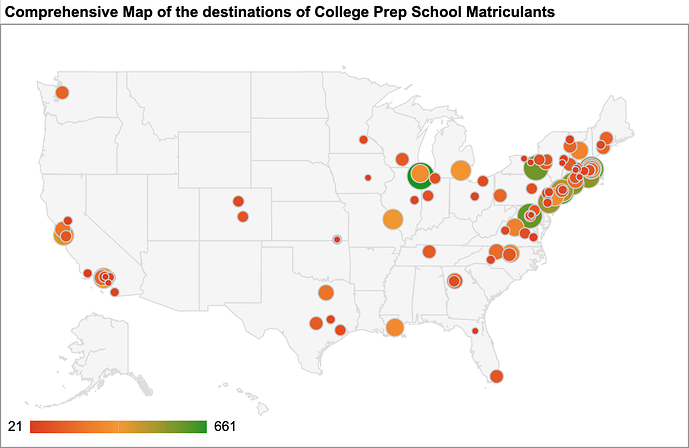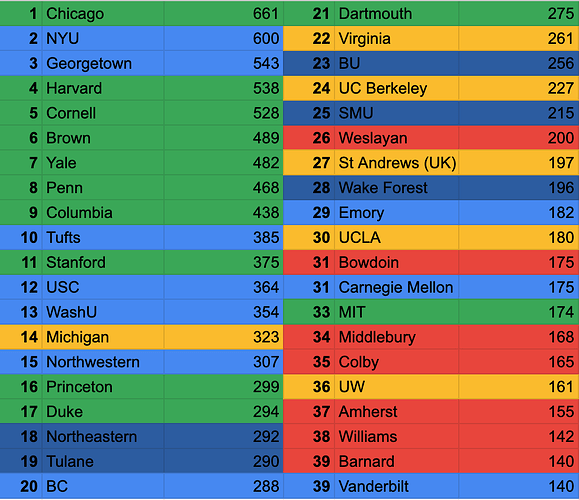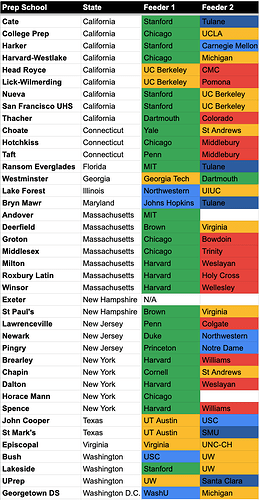This is an updated thread from last month’s which commented on the college matriculation rates from some of the country’s most elite/selective prep schools. After receiving some feedback, I’ve now updated the list to 40 prep schools to reflect a broader range of geographical diversity. This time round, I’ve looked at the most recent matriculation lists/school profiles of 40 prep schools (~16,000 matriculations) across the country (Andover, Exeter, Choate, Brearley, Groton, Lakeside, Harvard-Westlake etc.) to identify whether there has been any changes in popularity/feeder school magnets/general observations in geographical distribution. The standardized test scores of the average student at these prep schools typically places them within the top 5 percentile/decile nationwide. Tuition ranges from $35k up to $75k at the boarding schools.
Around 31% of graduates placed in the one of the twelve from the Ivy League + Stanford, Duke, Chicago and MIT (30 schools version: 37%). 22% went to other USNews top 40 private universities, and a further 13% went to private universities which ranked outside of the top 40. The most popular destinations were NYU, Georgetown, Tufts, USC and WashU. 13% went to public universities with the most popular being UMich, UVA, UC Berkeley, St Andrews (UK), and UW. Finally, 17% to LACs with Wesleyan, Bowdoin, Middlebury, Colby and Amherst being the most common destinations.
Main observations:
-
Prep school students are heavily concentrated at colleges in the the North East of the United States. Massachusetts - being the home of Harvard, Tufts, Northeastern, BC, BU, MIT, Amherst and Williams - was the most popular destination of prep school students by a long shot (no surprise).
-
On the west coast, California was the next closest with Stanford, USC, UC Berkeley and UCLA amongst the most frequently attended colleges.
-
21 states saw pretty much no college enrollments from prep school students at all, this includes: Alabama, Alaska, Arizona, Arkansas, Delaware, Hawaii, Idaho, Kentucky, Mississippi, Montana, Nebraska, Nevada, New Mexico, North Dakota, Oklahoma, Oregon, South Carolina, South Dakota, Utah, West Virginia and Wyoming.
-
Places which only some enrollment due to one prominent college in the state/country include: Iowa—Grinnell; Louisiana—Tulane; Michigan—UMich; Minnesota—Carleton; Missouri—WUSTL; Tennessee—Vanderbilt; UK/Scotland—St Andrews; Washington—UW; Wisconsin—UW-Madison.
-
Outside of the US, the UK/Scotland saw a fairly large number of matriculants due to St Andrews. Canada saw a few matriculants due to McGill and UToronto. Barely any prep school students went to colleges outside of these two countries. This means no colleges in other countries which offer degrees in English - such as Australia, England, Hong Kong, Ireland, Netherlands, New Zealand, Singapore and Switzerland - were popular with prep schoolers.
Would be interested to hear why you guys think some states just aren’t popular, the role of the politics of red/blue state determining college enrollment or whether it’s just because some states don’t have any well regarded colleges for those concerned with prestige.
P.S. Let me know if you want access to the Google Sheets which has an interactive map and the raw data for the schools.


